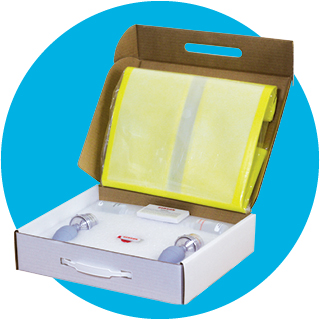Blog
Using an N95 Respirator? Don’t Get Left Behind on OSHA Guidelines.

Mythbusting Common Misconceptions on Wearing N95 Respirators
Whether you’re a healthcare professional or a patient, at this stage, pretty much everyone knows what an N95 respirator is, but many may not realize there are still common myths and misconceptions about using this PPE. If you or your staff are using N95 respirators, it is highly important to ensure that there is a proper respiratory protection program in place. This helps protect staff and patients by making sure the N95 respirators are functioning properly, and helps the practice avoid citations as well as potential fines. We have put together a few debunked myths and additional resources to assist you in staying informed on the changing landscape.
Myth #1: I’ve heard that the Occupational Safety and Health Administration (OSHA) has suspended fit testing, so we don’t need to do anything before wearing N95 respirators.
In an effort to conserve N95 respirators during the COVID-19 pandemic, OSHA issued temporary guidelines to suspend only the annual fit testing requirements, where users who have already passed fit testing with the N95 respirator of their choice would recertify on an annual basis.
However, fit testing is still required if:
- You are a new user to N95 respirators
- You have changed the model or size of your N95 respirator
- There have been any major changes to your facial structure such as cosmetic surgery, facial scarring, noticeable changes in body weight, etc.
Therefore, unless you have been using an N95 respirator previously and have been able to continue using the same type, fit testing is required.
Myth #2: Fit testing and user seal check (also known as a fit check) are the same thing.
There are two types of fit testing: qualitative and quantitative. A qualitative test uses the wearer’s reaction to taste or smell to generate a pass/fail result. Examples of this include being exposed to a sweet or bitter solution with and without the respirator to make sure the fit of the respirator is optimal. A quantitative fit test requires calibrated equipment and generates a numerical assessment of the amount of leakage into the respirator. Fit testing is required prior to first use of respirators.

A user seal check, sometimes known as a fit check, can be administered by the user after donning the respirator. The wearer would either inhale or exhale while wearing the respirator to check for leaks. This should be done every time the respirator is donned and is not a substitute for fit testing.
Fit testing is absolutely crucial in making sure that the N95 respirator is functioning as expected and filtering out harmful pathogen. Leaks of any kind would equate to sub-optimal protection for the wearer and anyone they are exposed to.
Looking for resources on fit testing? Our saccharin qualitative fit test kit available via your preferred dealer. The QLFT 50 Saccharin N95 Fit Test Kit is OSHA and National Institute for Occupational Safety and Health (NIOSH) compliant, and includes solution for approximately 55 tests. In addition, you can use GreenLight Dental Compliance Center™ by HuFriedyGroup to access the Respirator Fit Test Record to help keep your respiratory protection program organized and compliant.
Additional fit testing resources from OSHA:
Resources for OSHA guidelines:
(Be sure to check regularly as guidelines are updated often)
- OSHA COVID-19 updates
- Temporary Enforcement Guidance - Healthcare Respiratory Protection Annual Fit-Testing for N95 Filtering Facepieces During the COVID-19 Outbreak
- OSHA Respiratory Protection Overview
GreenLight Dental Compliance Center is a trademark of Hu-Friedy Mfg. Co., LLC, its affiliates or related companies.

